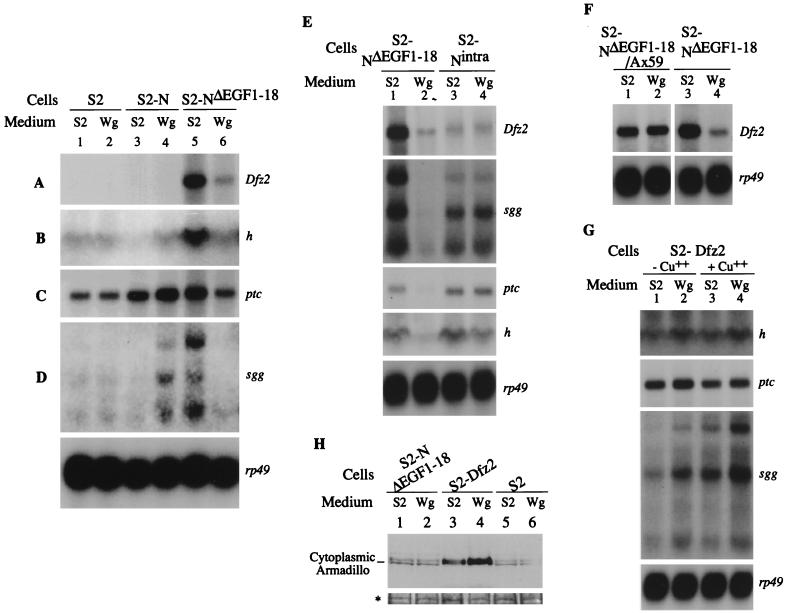FIG. 5.
N and NΔEGF1–18 have different ligand-independent activities and respond differently to Wg. (A to D) Expression of Dfz2, h, ptc, and sgg in S2-N and S2-NΔEGF1–18 cells are regulated by Wg. en, wg, ac, hh, and m5 and m8 of E(spl)C were not detected in any of the experiments. The sizes of transcripts of all genes were similar to published reports. Dfz2 (8), ptc (35), h (37), rp49 (61), and sgg (77). The largest sgg RNA corresponds in size to the embryonic transcript, while the smallest sgg RNA has a size expected for the ovarian transcript (77). sgg, wg, ac, and m5 and m8 of E(spl)C are known to genetically interact with N (15, 33, 71, 72, 85); Dfz2, ptc, wg, and sgg, are involved in epidermal patterning (4, 7, 8, 20, 35, 57, 65); h is a negative regulator of ac (38, 79, 84). (E) The extracellular domain of NΔEGF1–18 is required for regulation of Dfz2, sgg, ptc, and, to a lesser extent, h expression. (F) Ax59d mutation in NΔEGF1–18 abolishes Wg-mediated down regulation of Dfz2 expression in S2-NΔEGF1–18 cells. The two autoradiographs were derived from the same blot with different exposure times. (G) S2-Dfz2 cells (S2-pMK 33 cells [8]) do not down regulate expressions of ptc, sgg, and h in response to Wg, with or without copper induction. (A to G) Total RNAs were extracted from the indicated cells treated with M3 medium conditioned by growth of S2 cells (S2 medium) or S2-Wg cells (Wg medium) and analyzed by Northern blotting. The same batch of S2 or Wg medium was used for all of the studies. Gene sequences used as probes are indicated on the right of each panel. rp49 was used to indicate the relative levels of RNA in different lanes. The individual blots are exposed to film for different periods. Exposure times: rp49 < Dfz2 < ptc < sgg < h. (H) S2-NΔEGF1–18 cells do not accumulate Arm in the cytoplasm in response to Wg. The bottom panel (∗) shows a India ink-stained protein band visible in all lanes of the blot to indicate the amount of samples loaded. An anti-Arm antibody made in rabbits (kindly provided by Laurent Ruel) was used to detect Arm.

